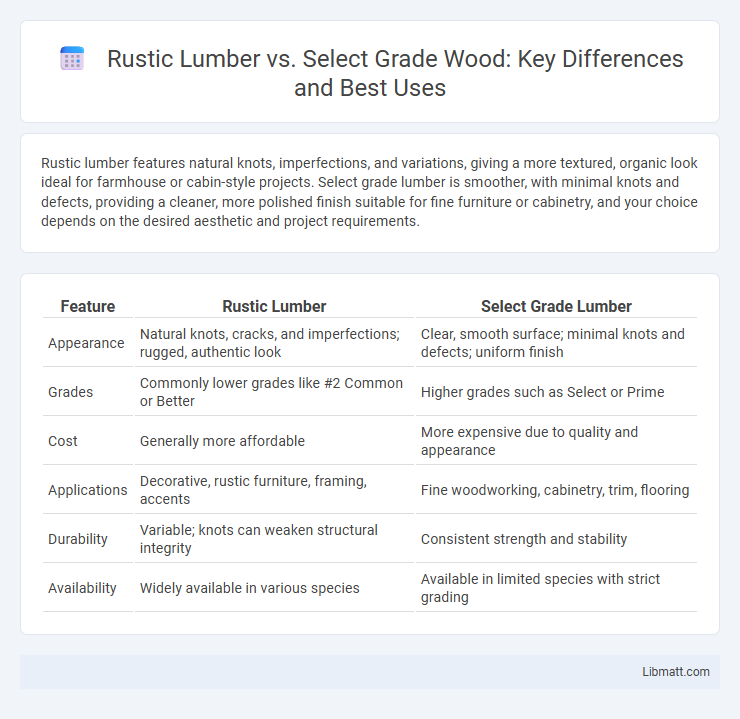Rustic lumber features natural knots, imperfections, and variations, giving a more textured, organic look ideal for farmhouse or cabin-style projects. Select grade lumber is smoother, with minimal knots and defects, providing a cleaner, more polished finish suitable for fine furniture or cabinetry, and your choice depends on the desired aesthetic and project requirements.
Table of Comparison
| Feature | Rustic Lumber | Select Grade Lumber |
|---|---|---|
| Appearance | Natural knots, cracks, and imperfections; rugged, authentic look | Clear, smooth surface; minimal knots and defects; uniform finish |
| Grades | Commonly lower grades like #2 Common or Better | Higher grades such as Select or Prime |
| Cost | Generally more affordable | More expensive due to quality and appearance |
| Applications | Decorative, rustic furniture, framing, accents | Fine woodworking, cabinetry, trim, flooring |
| Durability | Variable; knots can weaken structural integrity | Consistent strength and stability |
| Availability | Widely available in various species | Available in limited species with strict grading |
Introduction: Defining Rustic Lumber and Select Grade
Rustic lumber features natural knots, grain patterns, and imperfections, showcasing a raw, organic aesthetic ideal for creating authentic, textured wood surfaces in your projects. Select grade lumber offers a cleaner, uniform appearance with minimal knots and defects, delivering a polished, high-quality finish suitable for fine woodworking and cabinetry. Understanding the characteristics of Rustic lumber versus Select grade helps you choose the best wood type for your desired balance of natural beauty and refined elegance.
Key Differences Between Rustic and Select Grade Lumber
Rustic lumber features natural knots, imperfections, and a rougher texture, making it ideal for projects seeking a natural, aged appearance. Select grade lumber is cleaner, with minimal knots and defects, offering a smoother surface and more uniform color suited for fine woodworking and visible finishes. The choice depends on whether aesthetic authenticity or refined precision is the priority in construction or furniture design.
Appearance: Knots, Grain, and Color Variation
Rustic lumber features prominent knots, varied grain patterns, and wide color variation, giving it a natural, weathered look ideal for authentic, farmhouse-style projects. Select grade lumber offers a cleaner, more uniform appearance with minimal knots and consistent grain, perfect for refined, polished finishes. Your choice depends on whether you prefer the character and texture of rustic wood or the sleek, even look of select grade lumber.
Durability and Structural Integrity
Rustic lumber offers high durability and natural strength, making it suitable for structural applications where character and robustness matter. Select grade lumber features fewer knots and defects, resulting in superior uniformity and consistent structural integrity for precise load-bearing requirements. Both types meet structural standards, but select grade is preferred for projects demanding optimal strength and stability.
Cost Comparison: Rustic vs Select Grade Lumber
Rustic lumber typically costs less than select grade lumber due to its natural knots, imperfections, and varied grain patterns, which reduce processing expenses. Select grade lumber is pricier because it undergoes stricter grading standards for uniformity, fewer defects, and a smoother finish, ideal for high-end woodworking projects. When budgeting your project, choosing rustic lumber offers a cost-effective option while select grade lumber provides a premium look that may justify the higher price.
Applications: Best Uses for Each Lumber Type
Rustic lumber is ideal for applications where a natural, rugged appearance is desired, such as in cabin interiors, barn doors, and decorative beams, providing a unique character through knots and imperfections. Select grade lumber is best suited for fine woodworking projects, cabinetry, and furniture where a smooth, clean finish and uniform appearance are essential. Your choice depends on whether the aesthetic focus is on natural charm or precision and refinement.
Sustainability and Sourcing Considerations
Rustic lumber often comes from sustainably sourced, lower-grade wood that incorporates natural knots and imperfections, promoting the use of more readily available timber and reducing waste. Select grade lumber is carefully chosen for uniformity and minimal defects, frequently sourced from mature trees, which may impact forest regeneration if not managed responsibly. Understanding these sustainability and sourcing considerations helps Your decision align with eco-conscious building practices while balancing aesthetic preferences.
Maintenance and Longevity Factors
Rustic lumber requires more maintenance due to its natural imperfections and potential for knots and splits, which can impact its durability over time. Select grade wood, with fewer defects and a smoother finish, offers enhanced longevity and is less prone to warping or cracking, making it easier to maintain in the long run. Your choice will affect ongoing upkeep costs and the lifespan of your wooden surfaces or structures.
Aesthetic Impact on Design Projects
Rustic lumber offers a natural, weathered look with knots and imperfections that add character and warmth to design projects, making it ideal for creating a cozy, farmhouse or industrial aesthetic. Select grade lumber provides a cleaner, more uniform appearance with minimal knots and defects, allowing for sleek, modern designs that emphasize precision and refinement. Choosing between rustic and select grade lumber significantly impacts the visual tone and ambiance of interior or exterior spaces.
Choosing the Right Lumber Grade for Your Project
Rustic lumber features natural knots, imperfections, and character marks, making it ideal for designs emphasizing a rugged, natural aesthetic. Select grade lumber offers clean, uniform boards with minimal defects, perfect for projects requiring smooth finishes and precise craftsmanship. Understanding your project's visual and structural needs helps you choose the right lumber grade that balances appearance and functionality for Your desired outcome.
Rustic lumber vs select grade Infographic

 libmatt.com
libmatt.com